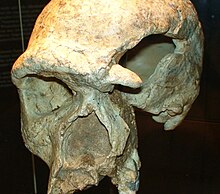Prehistoric Man Museum
The Urmensch Museum in Steinheim an der Murr was inaugurated on May 31, 1968. The most important and eponymous exhibit is a replica of the primitive human skull of Homo steinheimensis , which was found in Steinheim in 1933 and is around 400,000 years old. Other exhibition exhibits and topics are the geology and fauna of Steinheim and the surrounding area from the Paleolithic to the Worm Ice Age .
exhibition
Homo steinheimensis
The main exhibit is the skull copy of the "Steinheim prehistoric man". The skull was found on July 24, 1933 in the middle of a 15-meter-high gravel wall of the Sigristschen gravel pit by Karl Sigrist (1901–1972), the junior boss in gravel mining. The excavation was carried out by Fritz Berckhemer . The original find rests in a steel cabinet in the Museum am Löwentor in Stuttgart.
The skull comes from a woman around 25 years old who lived around 400,000 years ago. Damage to the left side of the skull and the base of the skull previously gave rise to the assumption that the woman may have been killed. According to recent forensic medical examinations, however, the damage has natural causes. Recordings in the computer tomograph showed that the woman suffered from meningioma , a benign brain tumor.
According to today's understanding, the name Homo steinheimensis only means that the skull was found in Steinheim. It is not a name for any particular type of human being. The classification in the tribal history of humans is still controversial today. The fossil is often attributed to the species Homo heidelbergensis , on the other hand it is also interpreted as a precursor of the Neanderthal . However, certain characteristics of the Neanderthal man are only vaguely pronounced.
A lifelike body model of the Steinheim woman has been a further main attraction in the museum since November 5, 2017.
Large mammals

The largest exhibit in the museum is the 4-meter-high skeleton of the Steinheim steppe elephant found in the Sammet gravel pit in 1910 (see illustration on the right; inventory number 12837 of the Stuttgart Museum at the Löwentor ).
The antler shovel of a giant deer ( Megaloceros giganteus subsp. Inc. ) Comes from the Pleistocene gravel of the Sammet gravel pit and was found in 1937 (see illustration on the right; inventory number 18270 of the Stuttgart Museum at the Löwentor).
The remains of European forest elephants, the skulls of aurochs, water buffalo and steppe bison as well as many other exhibits can be seen in the museum today. Most of the finds come from the cold and warm period terrace gravel of the nearby rivers Murr and Bottwar .
Showrooms
The museum consists of several exhibition rooms and extends over two floors. Finds of large Pleistocene mammals are found on the lower floor , while the development of early humans is shown on the upper floor .
History of the museum
According to a resolution of the Steinheim municipal council on June 10, 1966, the inauguration could take place on May 31, 1968. The museum initially consisted of a single room, a former classroom of the church school building in the so-called Hans-Trautwein-Haus (formerly the early morning measurement house). The house is named after the mayor of Steinheim, who was very much appreciated by the citizens at the time of the Thirty Years' War . Schools began in the building in 1565 and ended in 1963. Between 1965 and 1980, it housed the city library.
As early as 1974 the museum was expanded with an extension. The museum was completely redesigned from 1982 to 1983, at which time it was given its current name.
In March 2017, the Paris-based artist Elisabeth Daynès was commissioned to create a lifelike model of the Steinheim woman, which should clearly demonstrate what her whole body could have looked like. On November 5, 2017, the finished sculpture was unveiled in the museum. The costs totaled 45,000 euros, of which 30,000 euros were raised through a large private donation.
literature
- Karl Dietrich Adam : The man of prehistoric times - guide through the Urmensch Museum Steinheim an der Murr. Theiss, Stuttgart 1984, ISBN 3-8062-0404-7 .
- Karl Dietrich Adam: The prehistoric man from Steinheim an der Murr and his environment - a picture of life from a quarter of a million years ago.
- Raimund Waibel: Urmensch Museum - Steinheim an der Murr. In: Swabian homeland. 2, 1994.
- Homo steinheimensis - for the 60th anniversary of the discovery and the 25th anniversary of the Urmensch Museum in Steinheim an der Murr. In: Contributions to local history. Vol. 43, Steinheim an der Murr 1993.
- Reinhard Ziegler: 75 years of Homo steinheimensis. In (Ed.) Historischer Verein Bottwartal eV: history sheets from the Bottwartal vol. 11, Großbottwar 2008, ISSN 0948-1532 .
Web links
- Information from the Friends of Urmensch-Museum Steinheim eV
- Urmensch-Museum stadt-steinheim.de
- Brief information on the Urmensch Museum (PDF)
- Promotional video from Regio TV Stuttgart (1:04 min.)
Individual evidence
- ^ A b c Steinheim primeval man foerderverein-urmensch-museum.de
- ↑ a b Die Urmenschfrau is the new star Ludwigsburger Kreiszeitung, November 6th 2017.
- ↑ The Ur-Steinheimerin from head to toe Detailed explanation of the body model, in: Stuttgarter Zeitung / Marbacher Zeitung, November 18, 2017 (PDF).
- ↑ For more press reports on the sculpture, see the media review at foerderverein-urmensch-museum.de
- ↑ Pictures of the sculpture foerderverein-urmensch-museum.de, see there also other pictures (creation of the sculpture, transport, etc.).
- ^ Urmensch-Museum deutsche-museen.de
- ↑ Urmensch Museum gets a new attraction Marbacher Zeitung, March 15, 2017.
- ^ Primitive man as a lifelike sculpture Ludwigsburger Kreiszeitung, March 17, 2017.
Coordinates: 48 ° 57 '53.1 " N , 9 ° 16'45.5" E







